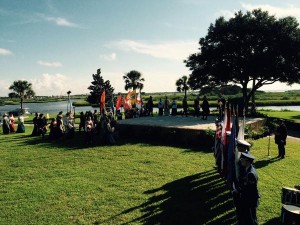On September 8, I traveled to St. Augustine, Florida to take part in the Diocese of St. Augustine’s founding celebrations. Here are some reflections on it that I shared with Bishop Felipe Estévez:
How very grateful I was to have the opportunity to take part in the reenactment of the founding of St. Augustine in 1565. I found this event celebrating 450 years of history to be very moving.
While the actual landing of Don Pedro Menéndez with 800 colonists took place on the feast of St. Augustine (August 28) in 1565, we gathered for Mass at the Cathedral Basilica of St. Augustine on September 8, the birthday of our Blessed Mother Mary, in honor of what likely was the date of the first public celebration of the Holy Eucharist. It is so fitting that the reenactment of the founding would be so closely tied to an act of worship and praise in and through Jesus Christ.
One of the goals of the celebration was to promote a peaceful harmony among all, grounded in a respect for the human person and for the land. I could not help but think of our Holy Father’s new encyclical, in the Latin entitled Laudato Si’, which echoes St. Francis of Assisi’s praise of the God of creation with the words “I give praise to God.”
In his encyclical, Pope Francis proclaims an integral ecology that beautifully integrates our deep respect of the dignity of each human being with our need to care for our common home, the earth. As I visited St. Augustine and saw the beauty of the land and the scene of the first Mass in Florida, I found myself giving thanks and praise to God.
Laudato Si’ also reminds us of God’s instruction to Adam and Eve in the book of Genesis (2:15) to go forth and both “till and care for” the earth. That call to be fruitful and to protect and preserve was so evident in the celebration. Indeed the rich history of St. Augustine reveals a people seeking to honor the dignity of every person…a great task to which the local church of St. Augustine committed herself to continue at the Eucharist later that day. So, too, Pope Francis calls all to preserve the land…to honor the land…a task we share with the Native Americans who inhabited the land before the foundation of St. Augustine in 1565.
Before the reenactment of the first landing, I had the privilege of joining Bishop Estévez and others on a visit to the archeological site of the first chapel and living quarters. At this site, the archeologists from the University of Florida are uncovering artifacts and piecing together life as it was lived centuries before. I could not help but marvel at the evidence of a very rugged existence filled with the daily struggle for survival. How grateful we are to our forbearers for their fortitude, bravery, and strength. I marveled at the remnants of the chapel…signs of the deep faith that accompanied these founders. Near the chapel base were small shards of pottery discovered and reassembled. We were told that the small ceramic chips likely came from Mexico and dated back to 1700 and even earlier. The blue of the shards was so vivid that it could have been fired in the ceramic furnace just a week ago.
After the reenactment, we traveled in a charming horse drawn carriage on the one mile route to the Cathedral for the Holy Eucharist. This was truly a celebration of the whole church. How wonderful for people from every part of the diocese to gather and so many bishops to support this fitting celebration. Cardinal O’Malley, a delegate of Pope Francis himself, was the principal celebrant and homilist. With wit and imagination, he delivered a marvelous homily extolling the importance of this celebration for the life of faith in the new world and for the growth of the Church.
Finally, in a gentle, humble manner the local bishop, Bishop Felipe Estévez, delivered a message that looked back to the roots of the diocese and ahead to a bright future – as he gave praise to our God in Jesus Christ and through the intercession of our Blessed Mother and St. Augustine.
As I thought about this experience, three themes emerge:
- The struggle for survival and the sacrificial spirit motivated both the indigenous people who inhabited the land and the pioneers who settled the land. We can learn much from their struggle and spirit.
- The spirit of faith was present from the beginning. The foundation of St. Augustine 450 years ago preceded many more waves of immigrants to the shores of the United States over the next 200+ years, many of whom were seeking the freedom to practice the faith that was present from the beginning here.
- The importance of the dignity of every human person and our common home was celebrated through a commemoration that did not simply look backward but also forward as it sought to bring unity, harmony, and hope to this wonderful community.
How thankful I am for the opportunity to participate. May God continue to watch over the people of St. Augustine in Florida!





